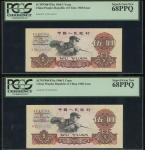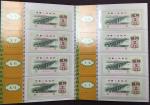1975年人民币2元券改进版纸币设计稿正反单面,评PMG53(有黏贴痕迹)及62(有黏贴痕迹)
「三七品」工程「文革币」见证「文化大革命」思潮的第三套人民币改进版纸币设计稿
中国人民银行2元券(军民团结保卫边疆)新中国的货币已经经历了五套,除了正在流通的第五套之外,其他四套人民币基本上已经退出了历史舞台。当我们回顾新中国人民币的历史,回味一张张熟悉而又逐渐陌生的图案,我们深刻地感触到,它们不但包含了深刻的经济和政治涵义,也默默记录下了社会的变迁。一个国家的货币样式,往往承载著社会的主流思维、反映著社会的主流价值观。
人民币设计变化都反映了中国社会思维的变迁。可以说,人民币的变迁见证了新中国的变化,记录了社会生活的酸甜苦辣,成为新中国一道深刻的文化印记。中国人民银行总行对第四套人民币的设计设想产生于1967年1月“文化大革命”初期,并提交了国务院,到1985年5月确定方案,历时18年。这期间经历了曲曲折折,受“文化大革命”极左思潮影响,方案製定也未免干扰,为此1967年2月至1976年5月期间,总行先后三次上报方案,经党中央、国务院的正确指导修订,最终极左思潮未能反映在国币上。
1967年1月,中国人民银行总行向国务院反映了湖北机械学院部分群众对人民币1元券天安门上没有毛主席像、红旗和标语提出尖锐批评的情况,同时提出了新版人民币的设计构想。2月,李先念批示:“应准备一套新版人民币,设计图景要多反映些生产关係方面的题材,克服第二套人民币生产力题材多的问题。”1968年7月16日,中国人民银行总行第一次向国务院报送新版人民币设计方案初稿,主要以“三突出”(突出毛主席的光辉形象、突出毛泽东思想、突出毛主席的革命路线)和“两个反映”(反映无产阶级文化大革命、反映社会主义革命和建设)为主题思想,当时受到週总理的严肃批评。
1969年4月8日,中国人民银行总行第二次向国务院上报新版人民币设计稿,票券画面主要是反映极左的内容,仍未获批准,后因林彪反党集团覆灭而作罢。1969年3月至8月,苏联军队分别在我国黑龙江省和新疆维吾尔自治区边境地区多次挑起武装衝突。製造流血事件。使得双边关係日益紧张。面对这种形势,我国的军队和人民团结一致,共同来保卫祖国的边疆。为了宣传军民团结保卫边疆的伟大意义和作用,1969年10月1日发行了军民团结保卫边疆邮票。
据《钱币报》报导,在当时的极“左”思潮氛围裡,曾出现过一种以革命样板戏为表现主题的方案,时间大约在1973年左右,参与设计的绝大多数是印钞系统的美术设计师。为保密需要,特取名为“三七品”工程。“三七品”工程中设计了军民团结保卫边疆的人民币。该票正面图案为天山军民骑马保卫边疆,背面图案为大型军工产品运输,各部分均为雕版印製粘贴,这也是第三套人民币改进图案后国务院未审查通过的设计稿之一。此枚设计稿样票雕刻精美,印製精良,带有鲜明的时代特徵,正反面的牡丹花卉图案在透视情况下完全重合,充分錶现文革后期中国的印钞技术水平。
此时我国已掌握了手工雕刻凹版印刷、凹印接线技术、套印对印技术和平凸版接线等印钞防伪技术。1975年11月18日,财政部(当时中国人民银行与财政部合併)第三次向国务院上报设计印製新版人民币的报告,设计方案的图稿主要反映社会主义新生事物和工农兵形象,如知识青年上山下乡、工农兵上大学、农业学大寨、工业学大庆等。同年12月29日李先念批示“放一放再说。”其中铁人王进喜的形像被中国人民银行设计到第三套人民币改进设计稿2元券上。
1976年5月10日再次请示,李先念批示:“暂时不办。”原定于1976年10月发行,但因当时发生毛泽东主席逝世和粉碎“四人帮”等重大历史事件而未能发行。到1976年“文化大革命”结束第三套人民币已经使用了15年。事实上,从国家的角度看,定期更换流通货币是防伪的最好措施,也是提高钞券印製技术的必要手段。粉碎“四人帮”以后,1977年11月15日,财政部再次上报关于设计新版人民币的报告,详细陈述了设计新版人民币的必要性和可能性,很快于11月21日获党中央政治局审查批准。也就是说,第四套人民币从最初筹备设计到尘埃落定正式与广大人民群众见面,历经特殊历史时期的百般曲折,其18年的酝酿历程,本身就是新中国一段刻骨铭心的历史文化记忆。
“三七品”工程中设计了军民团结保卫边疆的人民币设计稿,仅此一枚。为研究新中国货币史提供了重要的实物依据。是“文化大革命”极左思潮的产物。在人民币的货币史上具有无可替代的地位。原文由苏骏先生提供,张庭炜医生翻译。
Peoples Bank of China,an unissued printers model for 2 yuan, 4th series renminbi, dated 1975, obverse and reverse pair, the obverse: dark green and multicolour, soliders with rifles on horseback, mountains in the far distance, National Emblem at upper right, Er Yuanbelow, bank title four different scripts at upper left, peony flower symbolising wealth beneath, the reverse of this side shows the progressive underprint of reverse design, the reverse: dark green and multicolour, central vignette showing a large industrial truck carrying rocket engines.
The design was originally chosen to show the technological advancement of China at the time. The reverse side of this note shows the progressive underprint of the obverse design.The Three Seven Project: Currency of the Cultural RevolutionWitnessing the thoughts of the Cultural Revolution: A Printers Model of an Unissued Two Yuan A United Front of Soldiers and Civilians Protecting the BordersTo date The Peoples Bank of China has issued five series of renminbi notes and the memory of the first four issues are now slowly fading from our memories. When we look back on the banknote designs we can deeply feel the strong social, political and economical elements within. The design of a countrys currency will invariably incorporate these elements and the currency of the Peoples Republic of China is no exception.The concept of issuing the fourth series of renminbi began in January 1967 during the beginning of the Cultural Revolution and was only approved in in May 1985 after 18 years. During this turbulent period in which leftist thoughts were pervading the country many designs went unapproved. The Peoples Bank submitted three different designs between February 1967 and May 1976 and extreme leftist elements in the designs were rejected by the Party and State Council.
In January 1967 the central office of the Peoples Bank of China reported to the State Council that students in the Hubei University of Technology were dissatisfied that the Tiananmen Gate on the obverse of the 1 yuan note (second series) did not have Maos portrait, the national flag nor Maos statements (regarding world peace and unification) and at the same time stated its design concepts for a new series of RMB. In February of that year Li Xian Nian (Minster of Finance) instructed: …should prepare a new series of renminbi which incorporates more elements of (techonological) production so as to overcome to design flaws in the second series.On 16th July 1968, the Peoples Bank of China submitted its first series of designs for the new renminbi incorporating the Three Prominents(Prominent use of Maos portrait, Prominent promotion of Mao Zedong Thought and Prominent promotion of Maos revolutionary ideas) and the Two Reflections(Reflection on the Great Proletarian Cultural Revolution and Reflection on the Marxist Revolution). This concept was strongly criticised and rejected by Zhou Enlai. On 8th April 1969 The Peoples Bank of China submitted its second proposal for new RMB designs.
These designs contain strong leftish elements and were not approved. The demise of Lin Biao shortly after stopped this idea for good. On 8th March 1969 border skirmishes with Soviet troops in the Heilongjiang and Xinjiang Autonomous Regions became frequent. In view of this the civilians and soldiers in those regions formed a united front against the enemies to protect the borders of our Motherland. To promote this great and patriotic action a commemorative stamp named The United Front of Soldiers and Civilians Protecting the Borderswas issued on 1st October 1969. According to Qian Bi Post(numismatic magazine) because of prevailing leftist thoughts at the time, scenes from revolutionary operaswere used on the proposed banknote designs. This was kept a close secret and the codename Three Seven Projectwas used. Eventually a 2 yuan note was designed with obverse being The United Front of Soldiers and Civilians in Tian Shan Protecting the Bordersand the reverse being a large sized military transport loaded with rocket engines. The model is a collage of engraved printing and an unissued design that was not approved by the State Council. The model incorporated beautiful engraving, detailed printing and fresh design elements. The peony design (reflecting wealth) shows the advanced matching recto-verso printing and anti counterfeiting technology that the PRC possessed by the mid 1970s.On 18th November 1975 the Ministry of Finance (which included the Peoples Bank of China) submitted its third proposal for the new RMB design.
The designs incorporated the following elements: the role of factory workers, farmers and soldiers in a socialist society, e.g. the role of intellectuals in the countryside, the masses attending university and industrial schools. On 29th December the same year Li Xiannian instructed: Lets leave this for now.Shortly after the Wang Jin Xidesign for the 2 yuan was made and submitted on 10th May 1976. Li Xiannian finally decided to release the Wang Jin Xi 2 yuan in October 1976 but this did not take place because of Maos death in September 1976 and the subsequent arrest of the Gang of Four. At the end of the Cultural Revolution in 1976 the third series renminbi had been in circulation for 15 years. In the view of the state, regular replacement of circulating currency is good practice because of the need to update anti counterfeit features. The Ministry of Finance submitted its view that that the circulating notes need to replaced and this was finally accepted on 21st November 1977 by the Politburo.
From its conception in 1967 to its issue in 1985 the designs of the fourth series differed greatly to that of the third series and corresponds with the huge changes in Chinese society during the same period. The United Front of Soldiers and Civilians in Tian Shan Protecting the Borders2 yuan printers model designed by Three Sevenproject is unique and is an important historical item showing the progression of renminbi banknotes as well as a relic from the Cultural Revolution showing leftist elements. Its place in the history of the renminbi series cannot be underrated. The original text in Chinese was kindly provided by Mr. Su Jin and translated into English by Dr. Kelvin Cheung(Pick not listed), the obverse graded PMG 53 (Previously Mounted) and the reverse graded PMG 62 (Previously Mounted, Minor Stains). A beautiful design, UNIQUE and a crowning piece to any collection of Chinese banknotes. A true gem that should not be missed!!
































